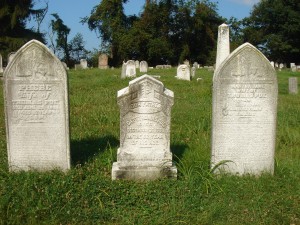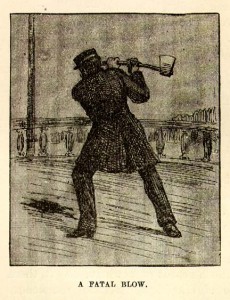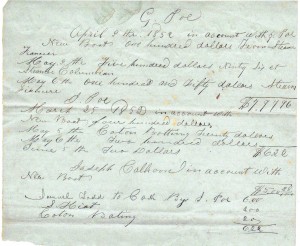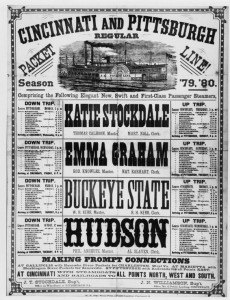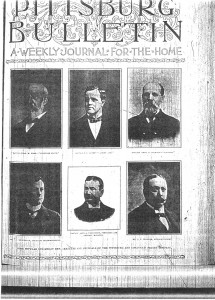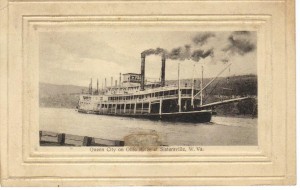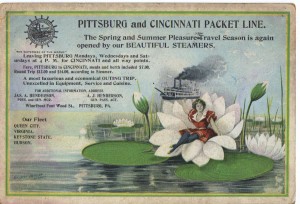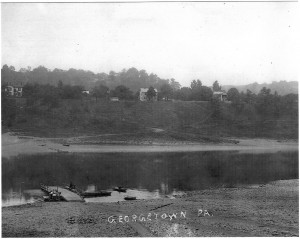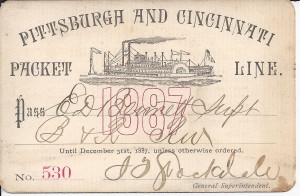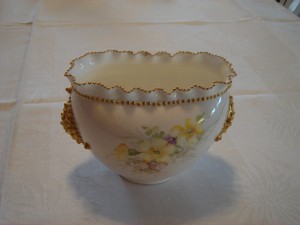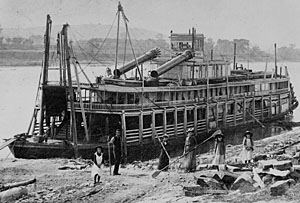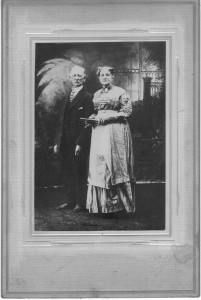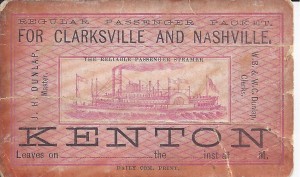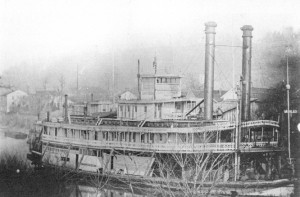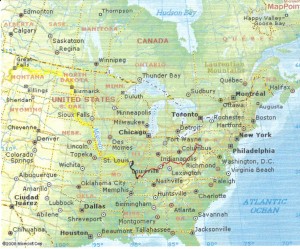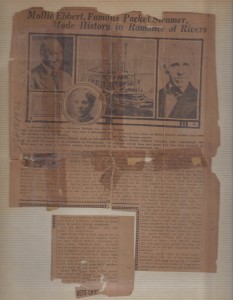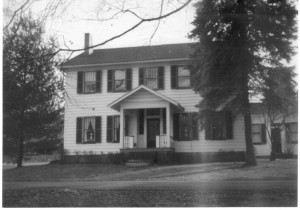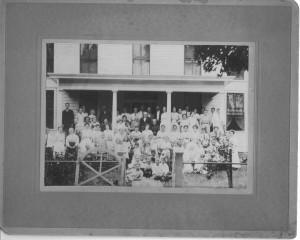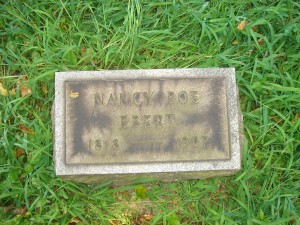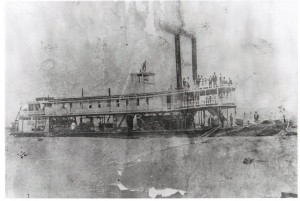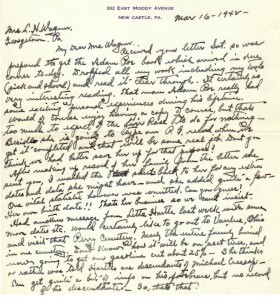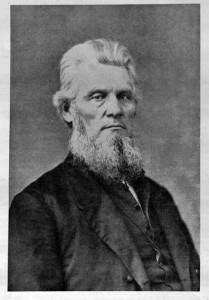Account of Adam Poe, Sr. River Experiences
written Georgetown, Penna. May 3, 1887
I was born in the village of New Lisbon, Columbiana County, Ohio on November 20, 1816. Have not as early recollection as parties I have known. When five years old, I recollect being put on a horse to ride behind my grandfather Adam Poe to Wayne County, Ohio but have not recollection of the journey and have no doubt but that I was well taken care of. I have been told by parties that I was the idol among my father’s family. I can remember a few happenings of the year I lived with him before my father moved out to the same place where the town of Congress now stands in Wayne County, Ohio. Father built a house for his family out of small logs and split flooring out of logs called puncheons and hewed them so as to level the floor. When the heat of the summer set in we all took the flu. As I was taken home, mother being a good nurse and well posted on the medicinal qualities of herbs growing in the woods, she brought us all through safely.
The following winter, father hired a man to bring his family and household goods to Georgetown, which consisted of five children. Later his family grew to ten children, five boys and five girls. At this writing two of each party are on the shores waiting until our change comes. The spring following father and eldest brother (Andrew) got work with the farmers in the neighborhood. There was not one dollar of money in sight. They were paid in the products of the farm, which kept the inner and outer man on terrafirma and always able for allowances.
When moving back to Wayne County, I was left near my birthplace at my Grandfather’s on my mother’s side of the house. Father came for me the June following and took me with him to lay a night line, was going to bait with worms. (June 1823 when Adam was six years eight months of age) Fishing with a night line was different to what it is now; put hooks on line, drop the line in the canoe and drop the staging over the side of the canoe, used a gourd for a buoy, and lifted the line every time they looked at it. So while father was getting his line ready in the canoe, he told me to go to a tree he selected standing under the bank, where there was dry sand and to sand the worms. He wished dry sand put in the vessel containing the worms, but I took them to the place he showed me, scratched a hole in the sand and buried the worms. He crossed the river for his line and asked for the worms. I told him they were on the other side of the river. He was quite angry as he had to make two crossings for the worms.
About two years later, father agreed to go to Wheeling with his canoe, from our place a distance of fifty-six miles, for the sum of one dollar. (1825 when Adam was eight years) Nothing occurred that I can remember except a heavy rain and windstorm at the foot of Brown’s Island. We housed in a fisherman’s shanty till the storm passed over; that was six miles above Steubenville. Our diet consisted of Johnny cake and meat, as that was the kind of bread the inhabitants of Georgetown lived on, and it was really good when gotten up right. I think if the rising generation lived a little more to that style, there would be less doctors’ bills to pay and people would live longer. t My mother was an artist in the way of getting it up right but her earthly career ended some years since, and she is now I trust reaping her reward for her many good deeds done on earth. (Elizabeth Hephner b1786 – d 1864) I feel rejoiced to know she lived to see prosperity in her family and could have had an easy life had she wished, She raised five sons and five daughters to manhood and womanhood.
We arrived in Wheeling the next day and lodged at Crowley’s Tavern, near the river at the upper end of the city wharf. One instance fresh in my memory was a small boy about two years old coming to the river to look at father’s craft with the old inn keeper. He was anxious to have him purchase it. The boy was a little crosseyed and would take the Savior of the World’s full name in vain when coaxing his father to purchase the craft. I will stop and think if Abe Crowley is still alive, he was schooled in a very bad element. Keel boatmen and the rough element did a great deal of drinking at Crowley’s Inn. A good story was told on Captain Stone’s going up through Merriman’s ripple where the channel runs close to the shore. Captain Stone said to his passengers “There is a lame man going our way” and called out to him, “Will you come on aboard if I stop for you?”. “Oh, no, I am in a hurry, thank you”.
The last remembrance I have of our canoe trip was the first night our of Wheeling. I got so sleepy, I laid down in the bow of the canoe and went to sleep. On arriving at the upper end of Wellsburg, father landed and carried me out to a flat lying on the shore to get sleeping quarters for the night. The reader will remember that a trip occupying nearly four days with a man and a boy, could not pay many hotel bills with one dollar, and they were not paid until the trip was performed.
The next trip I remember was a small raft of logs father had gathered up to take to Mr Murray’s saw mill at Steubenville, Ohio where they were beginning to build small steamboats hulls. The recollection I have of the trip is father’s running on the Virginia side of Baker’s Island about one mile below Wellsville, Ohio. Before the government built the dam at the head of the island, the shallow water was near the foot of the island and very swift. The raft was built of logs in the river. Some of the logs were large and some small and all were round. When the large logs began to come in contact with the bottom of the river, they rolled under the small ones. It was a lively time for father and I to keep from getting between the logs and getting crushed or drowned, as David Crockett said of the wagon getting away from the driver or getting out of his control. Going down the Allegheny Mountains he was a passenger in a wagon, it being loaded with flour. He said a rat could hardly live, let alone a man. I tell you a fish would have done some good dodging had it been mixed up with father’s logs. I have no remembrance of the trip, only I suppose we rafted them over and took tem to Steubenville.
The next boating was on a raft of hoop poles. I was about nine years old. We took it to Moundsville, West Virginia. One incident I will never forget. Father walked home and I trotted after him. When we arrived at the head of the narrows above Kate’s rock, father stopped and said to me, “I will find the place where Captain foreman with his 21 men were buried; waylaid and murdered by the Indians.” There was a large quantity of beads found in the path; was supposed the party that buried them to belong to the Indians. Grandfather was Captain of the fort below the mouth of Yellow Creek. He was called to help bury the dead. It was a long distance to go to a funeral, but Grandfather had a commission from the government and had to go when called upon. The distance from Yellow Creek is 56 miles. Remember nothing more of that trip.
About 1824 or 1825 there was a pair of French Creek flat boats at our village. Size of the boats 80 feet long by 16 feet wide, made large at that time for transporting coal to the south. My father, Thomas Poe, Sr. hired as a hand to go to Cincinnati at 50 cents per day. There being a sudden rise in the river, boats floated to Cincinnati in four days and nights; so father had two dollars wages coming to him, with four dollars back pay. Steamboat passage was scarce at that time. If he had struck a boat it would have cost him about $6.00 and would have been ordered around like a dog. At that date boats only burned wood, and it had to be carried often a great distance. Father was well posted with the nearest directions across the State of Ohio, as he had once been employed as a pack-horse for John Beaver and Joseph Larwill in Laying out the State, or the eastern part of the state. Father was a good woodman and could tell the direction he wanted to go by the moss on the trees, as moss grows on the north side. He arrived home in about ten days without having spent very much money out of the big pile he left Cincinnati with.
In those days it was the custom in our neighborhood to get your wheat ground and ship it on one of the keel boats that ran in that trade. Most of the farmers were good poling hands. On my first trip I was not big enough to cook , and before starting procured a broken pole and got it rigged up for service, concluding to be a pole hand. I could reach as low as the old hands, and had no trouble until going up the smooth rock shute at Montgomery’s Island, six miles below Beaver, Penna. My pole would not reach and in getting down on it the pole slipped and sent me to the bottom. An old farmer caught me in time to keep the turtles from eating me.
In the fall of 1834 father was in Pittsburgh, the river was very low. One of the Beaver County farmers bought an old boat and hired another and headed the three boats for Wheeling and intermediate landings. The farmer was sharp enough to collect most of the freight bills and left the boats to the care of father, so father bought an old horse to tow up the empty boats, came to our boat at Warren, Ohio and found it laying at the bottom of the river. I said to father, “Better leave the old boat and go on with two” but father became offended at my words. He was feeling rich at the time and handed me $3.00 in silver. I dashed them to the floor. Some of the hired hands present gathered them up and forced them on me, as I would have went off with nothing. I saw a steamboat coming up the river and I hailed her, and with that purpose in mind, chased her to Beach Bottom where she came close enough to send a yawl for me. I got home the next morning. Mother was sorry I had left father, as she knew I was important help to him.
My two older brothers came the next day from Pittsburgh with their boats headed for Zanesville. Mother coaxed them to take me along. When I got home father had yielded enough to let mother coax me back to help him. I helped him part of the winter and also bought one of his boats.
He laid up the winter at Steubenville. About January, there came an open river. I took a crew of hands from our place, borrowed five dollars from my two older brothers to provision the boat for the trip. James Means furnished me with two hundred barrels of flour for my first load. I got up as far as Georgetown (my native home) where I found the river to be frozen up. I hired a sled and hauled my goods to a warehouse. When spring came I loaded up again. I painted the boat over and named her Victory, as I started out to gain a victory or die in the attempt. My first freight trip netted me $50.25. There came a strong west wind and we sailed almost all the way to Pittsburgh. I paid my hired help 50 cents per day; five days were required for the whole trip. I cleared about $25.00.
Arriving at the city, I paid off all but one hand and the cook. I got a load of salt of blooms for the Iron Mill above Wheeling, and then went to Wellsburg, West Virginia. Called on Farr and Curran who shipped a great deal of flour to Pittsburgh, and when they learned my name, I certainly was their boy.
They gave me three loads in succession. When I returned they seemed to take a great interest in my welfare because of my grandfather’s history fighting the Indians. Philip Dodridge, who penned the first history, was a Wellsburg man. I ran the Victory that season. I sold my boat to some trading parties to load for the south. I found the only chance for me was to hire out on a steamboat and learn something that would pay me.
I hired on the first steamer Beaver, built by Charles Stone to tow freight and carry daylight passengers from Beaver Falls to Pittsburgh. The boat was about worn out. George M Horton to command of her and extended her trips to Wellsville, Ohio. Was running on the south side of the river 16 miles below Pittsburgh when the boat picked up a snag, broke through the hull and ended up through the forecastle. The boat sank in less than three minutes and had sunk up to the hurricane deck. The owners wrecked her.
The owners of Beaver #2 put her in the Allegheny River trade. As time passed, the Beaver and Pittsburgh trade played out. They put Jacob Poe on as her Captain. At that date there was but two Allegheny steamboat pilots. The steamer New Castle was about the first boat to make a trade in te Allegheny River from Pittsburgh to Venango County, Penna. Brother Jacob Poe acted as Captain and First Pilot and hired me as an assistant until we got as far as Kittanning. We heard of a raft pilot there and got him on board. Going up the river, he knew little more than ourselves, particularly at night, but was well posted downstream as he had only floated rafts from the head of navigation to the City of Pittsburgh. After as few trips, James Dougherty got to drinking so much he became a nuisance on the boat and my brother paid him off and discharged him. We were going smoothly when an accident happened.
The boat was supplied with cylinderboilers,30 feet long, 18 inches in diameter, five doors about midship of the boat, chimneys forward same as a fine paddler. About Montgomery Falls, the engineer Robert Watterson turned a throttle valve on the boat in the river, lost sight of the water in the boilers. He set a fireman to removing a pile of coal alongside the boilers to find the check valve. I was off duty at the time, not sleeping very sound on account of it. I was immediately over the boilers when I heard a noise like packing blowing out of a cylinder, and heard three men scream violently. The boilers had become about dry and were red hot; the steam had burst a hole in the bottom of the boiler and escaped downward, badly scalding the three firemen. If there had been much water in the boilers the firemen would have been killed at once.
Robert Watterson was employed by the same company and followed the river till he saved money enough to purchase a good farm in Beaver County. The owners of the Beaver repaired her after getting her towed down to the city and loaded her and her two keelboats for Zanesville with Captain John May, an old veteran steamboat man, in command. Below the locks at Duncan’s Falls the boat got tangled in the ferry rope and the captain had to cut it. The boat could not pass through the locks, they being too short, so the freight was taken off the steamboat and loaded on the two keel boats. Captain May sent brother Jacob and myself, we being experienced keel boatmen, to take the boats up to Zanesville, a distance of 90miles. The keelboats were loaded so deep that we were forced to load the boats yawl, and tow it along the dam at Taylorville locks. The locksare12 feet high, but there was a considerable break in them. We concluded not to lock the empty boat as we were afraid the ferryman might capture it for cutting his rope, so we concluded to jump the dam. I guess if we could have stopped when we neared the dam we would have risked the locks. It was the merriest jump I ever took, all hands sat down and held on to something.
About 1834 I shipped on the Steubenville packet boat. She had three small keel boats. Left one at Steubenville and one at Pittsburgh. This boat was built in East Liverpool, Ohio. She was open from forecastle to transom, had five cylinder boilers 20 feet long and 18 inches in diameter, fired at the midship of boat and was very hot; came out with Captain Dick Huston. Afterwards the Steubenville owners put Joseph Filson in charge. She had not power enough to comply with the trade and was sold.
I shipped on the steamer New Lisbon running between Wellsville, Ohio and Pittsburgh, Penna. carrying daylight passengers and towing keelboats all the time, leaving one at Pittsburgh and one at Wellsville. It was the custom for the deck hands on those small packet boats to dine in the cabin, but Captain Hamilton Smith began to feel rather proud and had a board for the two deck hands. I did not answer the call and, of course, got no dinner. Captain Smith came to me for an excuse and I told him I did not wish to break the rules; that he could get plenty of men to dine below, as I was only staging in short trade on account of the fare and I wished my money as I was going to quit the boat at Georgetown. I had loaned the boat some money to start out on and had some wages coming to me. The boat did not have enough cash on hand to pay me until she would return from Wellsville. I ate in the cabin the balance of the trip back to the city.
When I got to Pittsburgh I found a steamer called the Coquette loading for Lafayette about the head of navigation on the Wabash River. The boat was owned by Aaron Hart, and in after years he became one of my river friends. ‘He was a good man, I shall never forget him’. I shipped as a deck hand on her. At that time it was thought that a party coming off the Ocean or Lakes was better fitted to command or mate a steamer on the Ohio River. Captain Hart put a Captain on the Coquette, a fellow (I will not call him a man as I think it requires certain qualifications to make a man). His name was Fennel and he hailed from Lake Erie and had his own mare along from the same place.
After going to work on that boat, the mate told me to go back to the after scuttle and get a selvage. I went back to the little hatch, but I did not know what a selvage was by that name. I did not want to lose my standing as a boatman, so I told him I couldn’t find it. The selvage was made of tarred rope or spun yarn and was used to loop over the head of the spar to push the boat away from the wharf. A selvage would not answer that purpose at a wharf in the city as the wharf was crowded with large heavy boats and we had to use large spars and blocks and for a selvage we used a strong sea grass rope to fasten the block to the head of a spar.
The boat left Pittsburgh with John D Mackall and William Casey as pilots, as they were old keel boat men; they knew the river better by day than at night. Mackall had no confidence in himself, and would send for me to look out for the head of islands, as he was from our village and well acquainted with me. That trip was one of the hardest trials of suffering of my life. The boat was narrow and having some deck load it was hard to keep her fair on her bottom as it was stormy March weather. The boat had 1000 lbs. of chain on a four wheeled truck which my partner and myself had to stand by and haul to the high side of the boat. We were not allowed to the fire doors to warm. The Captain took one look at the boat’s leads and drove a spike through the line into the jackstaff as high as he could reach, to serve as a plumb line, and gave us orders to stand by and keep the boat trim by it.
Nothing unusual happened until arriving at Louisville. Mackall at the wheel rounded the boat into the mouth of Bear Brass Creek. I suppose he was scared, as it was night, and never stopped theh engines until the boat lifted herself nearly dry in the mud at the mouth of the creek and came very near running into a produce boat. The mate set a spar and put all the strain on it that the guards on the boat would stand. It was customary at that time for boats to carry very large hawsers, to hawser-out at hawser hole at the stern of the boat. Nothing out of the usual order of steamboating happened until we reached the mouth of the Wabash River except hard work for us deck hands.
In due time we arrived at Lafayette and got all the freight out. The Captain got a few hundred barrels of flour back. All of us deck hands were entirely worn out and we told the Captain we were not able to work anymore. He showed some humanity by telling us he would get some laborers to put it on the boat, which he did, and we stowed it away.
Nothing out of the regular order happened on the return trip until one night as the boat was making a very short turn, the chain wagon took a start from the high side of the boat and ran under the old-fashioned rail, which was almost 18 inches high, and went overboard as the chain was passed out of the hawser hole and back to the anchor. The chain was safe. We got it to the capstan and hoisted it back on board. We laughed, but our laughing was turned to sorrow for we had to use a two wheeled truck the balance of the trip, which was very hard work. After getting the chain o n board, the boat landed and we had to carry wood from off the bank all night and put it in the hold. The pilots did not wish to run at night. Wood was cheap on the Wabash and it only kept us deck hands in steady work to bring it up to the firemen.
Now I am nearing the point where I saw the brute acted in full force. Early Sunday morning we took a wood boat in tow; it had about a dozen darkies on board. At Caseyville, Kentucky when the boat came up near the town and was in the act of letting the wood boat loose; one of the colored men as ked the mate if he was going to land, and the mate said yes. The darkie jumped aboard. The boat started to cross over to the Indiana shore and the colored man began to cry and was in great distress. The boat kept on going up the river. Henry Sutton, a pilot that we got in Louisville, came down on the forecastle and took a rope’s end and whipped him unmercifully. Then Captain Fennel exhausted his strength on him and tied his hands behind his back and tied him to the capstan, and there he stood till evening. When the boat landed at Bradenburg, they put him in jail. I stoodup for him like a man although I was only a boy, and contended that the mate told him before he jumped out of the wood boat that he was going to land in town. I think this trip ended Captain Fennel’s boating on the Ohio River. I suppose he went back to Lake Erie where he could play sailor on a small scale.
I afterwards made a trip on a pair of coal boats from Pittsburgh to Louisville late in the fall. Mackall was pilot and I was a hand. We took passage at Louisville to return home on the deck of the steamer Ontario. We got up the river as far as Letant Falls, about midway between Cincinnati and Pittsburgh. On account of floating ice, the boat could not stem the falls. On Monday morning we left the boat at Graham Staion,200miles from our homes, and started out to try the red limestone mud. It froze and thawed most of the time during the trip home. We struck the Ohio River again at the foot of Blenerhasset Island and followed the river the balance of our journey Going through Belpre settlement, I was taken with a pain in my right hip joint. I wanted Mackall to go on and leave me, but he would not, and instead would urge me to stand up to the work. Mackall was a very good traveling companion. We averaged about 35 miles per day. I arrived home on Saturday evening, having made the trip in six days.
I afterwards made a trip from Pittsburgh to Louisville on the steamer Norfolk. Nothing out of usual order happened on this trip except hard work, as boats in those days had to be washed and scrubbed every morning from hurricane deck to forecastle and the water had to be drawn from the river in buckets. William Leonard was pilot; he afterwards piloted boats from St Louis to New Orleans.
My next trip as deck hand was from Pittsburgh to St Louis on the steamer Dolphin commanded by Captain Carmack, who was a perfect gentleman. William McDonald was the mate, a very clever man he was. Everyman had to be at his post. McDonald soon afterward became a pilot in the Pittsburgh to Cincinnati trade. At the falls there was only six feet of water, and as the boat drew more than that she began to roll and tumble over the rocks long before she came to the worst part of the channel. Looking forward we could see the waves running high. I thought she would not go over without sinking. I was born with the gift of taking danger coolly and to take the best plan fro the preservation of my own life. I was standing near the mate on the forecastle. At every roll of the boat he would swear a big oath, and as I watched his face I could see that he was alarmed, so I spoke to my pardner Thomas Madden that there was danger. A lot of gangplanks were lying by the guards. I got Thomas to take one end of a plank and I took the other, thinking that if the boat did sink, that plank would carry us ashore. When the boat got over the falls, the mate found that the braces that hold the cabin up over the boilers all removed from their places. At that time there were timbers across the boilers, and short posts were used to hold the cabin off the boilers.
Nothing occurred until one night another party came on board that was not recorded among the boat’s list of passengers. It was mixed up among a large family that was going west, and was in-charge of a daughter and a son-in-law. Everything went alright until the boat arrived in St Louis. There was a large pile on the forecastle about 15 feet high. As soon as the boat was fastened to the wharf, the mate told us to carry the lumber ashore. It was raining hard but there was no chance to get out of it. Reader — “Think of a man going to his bed when he only had a pine board to lay on, with scarcely any covering, and the water dripping from the clothes, with no fire and nothing to dry them except the heat from his body’.
In 1836 keel boating was good, and I got a boat built. I called her the Brazil #4 and run her in the Wheeling trade. The last low water trip in the fall, I got good prices and got all the dry goods I could carry in the boat. The tonnage of boats then was about 50 tons. I could not get a crew of hands sufficient to handle the boat and at Racoon bar, below Beaver, she got badly aground. Early in the morning, myself and one man waded ashore and at Two-mile Ferry we high a lighter. It took nearly all day to get the boat afloat; it rained hard most of the time. We started out near evening, the wind commenced to blow from the west and it began to get cold. We beat against the wind until we came to a small house at the head of Montgomery Island where we stopped for shelter and to get our clothing dry. I stood at the helm until I was chilled to the heart. They had a large wood fire where we warmed ourselves and it seemed the happiest moment of my life. It is necessary for one to suffer to appreciate real comfort. The next trouble we had was at the foot of Babbs Island above East Liverpool. There came a snow storm which drove the boat out of the channel and she stuck badly on a rock. The hands got into the river and tried to pry her off. When we got to Wheeling, my brother came down the river with the old steamer Beaver. As she was a light tow boat he hired my boat. I cleared $200.00 on my trip. I kept my boat under charter until winter and then closed her out.
About 1837 my brother and myself had a keel boat for low water in the Wheeling trade. In the latter part of the summer I purchased a quarter section of land in Missouri. My brother said he would take care of our interests in the boat so I started out to find my land. I could think of no better way, so I hired out on one of the large keel boats that carried dry goods to Louisville. At Louisville I found the steamer Massillon going to St Louis. I took deck passage and had a good time as I fell in with some Kentuckians who were going west to look for land. The boat was crowded with passengers, both in the cabin and on deck. John Day was Captain and Alexander Forsyth, his old keel boat clerk, was mate. Forsyth afterward pushed a deckhand overboard into the canal at Louisville. The man was drowned. Forsyth went up to his room and put on a broad brim hat and walked off the boat and escaped to Pittsburgh. He was never punished for the crime. He afterward married and bought a few acres of land in Beaver County at the head of Crow’s Island. Forsyth was Captain Day’s right hand man as Day could not read and would have to ask the name of boats that were passing.
At St Louis I found a small boat bound for the Missouri River, commanded by Captain Kyser, an old veteran on that river, who had a boat called the Shawnee. The water was too low for her and he chartered a lighter boat called the Izora. I took passage on this boat. As usual, the boat laid up every night to clean te boilers, as a mud valves were not used then. My destination was Glasgow, Missouri. I showed my patent for my land and was directed to go seven miles back in the country and call on Esquire Bradford, who could give me all the information about my land, as he was an old surveyor. I stayed with him that night and found the land almost joined his, and also it had been sold for taxes. Next day I went to Keysville, the county seat, but got no information as to who owned the tax title to my land. I arrived back at Esquire Bradford’s the same evening. The squire had no wife, lived in a log cabin and had an old colored women keeping house for him. He had plenty of bacon and honey and she made corn bread. Next day the squire surveyed my land, got two men to carry chain, and another old man came down to see it done, and in talking with me said, “That the squire was a good man, and if it was not for the family of a quarter blood children that he was raising by a yellow woman who lived on his farm in another house, he could be elected to any office in the county.” I had to back to Jefferson City to find out who owned the tax title to my land. I walked to Glasgow and took a stage to Fulton, the latter place being 20 miles from Jefferson City, which was a distance I had to walk, as there was no conveyance. I had to cross Howard and Boone counties. A gentleman pointed out to me the place where Daniel Boone lived and died.
About night I came to a farm house. A man and his wife were the only occupants. They took me in and treated me kindly. I was stills even miles from Jefferson City, which I reached the next day. I got my business done and got ready for the next steamer that came down, which was the Zora. The mate took the boat across the river, and while at dinner, the sand washed out from under the boat. Every man was at his post. The pilot discovered that the channel had gone to the west side of the river. While running down a small channel, the pilot saw a pile of logs ahead and stopped the engines. The boat got crosswise in the channel and ran up on the pile of logs until the pipes that took water for the boilers came out of the water. No water could be got into the boilers. The only way the boat could begot off was to run a hawser ashore. They soon pulled the boat off and we got to St Louis alright. At St Louis I hired out as a deck hand on a steamboat called the Maine, bound for Cincinnati. All went well until we got to Flint Island where the boat got aground. We finally got the boat freed and continued up river. Finally arrived home without further event.
In that summer of 1840 I shipped as a mate on the steamboat Orleans. She ran between Pittsburgh and Louisville. R. S. Langham was captain, Hart Darragh clerk, Monroe and William Hart engineers, and Charles Rankin and Benjamin Wilson were pilots. The boat did not answer her helm very well and the pilots missed the channel often, and when the boat got aground I had to spar her off with an old fashioned hand capstan. The Orleans was the first boat that had a pump called a ‘doctor’ was used on. It was used for supplying the boilers with water when the engines were not running in side-wheeled boats. Stern-wheeled boats were better off as they could uncouple the engines and pump water into the boilers whenever it was necessary to do so. The doctor was an oscillating cylinder with a flywheel about four feet in diameter and would very often stop of its own accord and we would have to lift it over center to get it started again. About the same day the Vicksburg was so perfectly blown away, a storm struck the Orleans as she was nearing the Kentucky shore at the 12-mile Island above Louisville. She headed for the Indiana shore, and as the boat was light, she listed until the upper guards were under water. The pilot did not stop the engines until she ran against the bank and forced herself between two tree so tight we had to cut one of them in order to get the boat loose after the storm has blown over.
The same fall my brother and myself bought a small keel boat and loaded it with goods for the Forkadeer River. As pilot, I was the only one who had been as far down the Ohio River as Cairo. We bought a book called the “Western Pilot” and ran by it as well we could. Got near where the Forkadeer empties into the Mississippi. We landed on the Arkansas side and made inquiry as to how far it was to Hale’s Point. Had hard work getting up the Forkadeer River, first threer days saw no person on the shores. First landing was at the Widow Ferral’s Ferry five miles from Dyersburg. Done some trading with the Dyersburg merchants. We went up the river to Chestnut Bluff where we put our goods in a house and sold our keelboat for $100 to a noted gambler. After he gave us a $50.00 note, brother and Potts started home. When they got to Louisville, the note was pronounced counterfeit and they returned it to me by mail. I had allowed him to take the boat down to Widow’s Ferry, and he had promised by a certain time to pay the other $50.00, so when the counterfeit note came to hand, I started for the ferry in haste. I walked ten miles in 2hours and a half, but thet boat of the gambler and widow and family were out of my reach. Some parties thought they had gone to the White River, Arkansas. I got some colored men to hew me out some gunwales and I had saved some pine boards out of the keel boat and I built a small flat to carry our household goods to the Mississippi River; got passage on the Helen Kirkman bound for Nashville; had to get off at Smithland; got passage on the Scotia bound for Louisville; took passage to Cincinnati on the mail boat Ben Franklin. At Cincinnati took passage on the Richman and stopped at East Liverpool and walked to Georgetown where I resided.
That same spring, my three br others and myself bought the old towboat that Falston (1837) had. Two keelboats that we used for freight furnished the cabins for passengers. The fall we built engines for her. Three years later I built the steamer Financier (1845) for the purpose of carrying freight and passengers in low water between Pittsburgh and Cincinnati. Afterward sold her to Captain William Kountz.
Then I ran the Cinderella (1847) four months and cleared eight thousand dollars. I then sold my half of the boat, quit the river and tried farming, but found it an uphill business. I then built Financier #2 (1850) and ran her for three years; built the Royal Arch and sold her, and then built the steamer Ella (1854). The railroads had spoiled the low water business between Pittsburgh and Cincinnati, but the rates were high for freight from Cincinnati to St Louis. I left Pittsburgh without any freight to run between Cincinnati and St Louis. Got as far down as Coxe’s ripple near Wellsburg, West Virginia; got aground and gave it up for about a month, then there came a heavy rain that raised the river at that point and floated the boat off the bar. I gathered up part of a crew and started down the river. The boat rubbed the river bottom through every ripple until we got to Blennerhassot Island; there was so much sand washed up on the bar at the foot of the island that there was six inches less water than the boat drew. I hired a man with oxen and scraped and dug a channel through the bar and got to Cincinnati all-right, got plenty of freight and passengers for St Louis at high prices. We took on all the freight we could carry..
Nothing out of the usual order of boating in low water occurred until we arrived at Paducah, where we took on board six southern gentlemen who bore the title of Doctor and whose destination was New York. They got off a heavy boat on account of low water. They had to return by way of St Louis. Their business was to negotiate for the building of the railroad thru the South, having in view the transportation of soldiers should the country be assailed.
The first night after passing Paducah, another passenger arrived on board. The passengers told Mr Wilder and his wife that they must name him after the Captain, so the little stranger was named Adam Poe Wilder. All went well and we landed Adam and mother about eight miles below St Louis. I have never seen nor heard from Adam since.
The next spring (1855) I took a load of freight and passengers on the Ella for the upper Missouri (should read upper Mississippi), destination Galena and Dubuque. At Evansville, we took on a tramp who had but $1.50. The clerk let him help the cooks for the balance of his passage. Having no cargo to put out at St Louis, we landed at the upper end of the wharf, and as the bank was very full, the current was running pretty strong. While taking on our pilots and stores, a lady let an infant child fall from her arms into the river. The brave old tramp jumped into the water and caught the child before it sank. I heard the racket in time to see him make the wharf some ten feet above two barges that were moored below our boat where he and the child were pulled out of the river alright.
Nothing else out of the usual order occurred until we arrived at Keokuk where we had to take out some 200 tons of freight to lighten our boat so we could get her over the rapids. Mr Hines furnished lighter boats and towed them over the rapids with his light towboat. At Montrose I was told that the tramp and another deck passenger had died while crossing the rapids. At Montrose we applied for permission to bury them but the authorities would not allow it, thinking they had died of cholera. Laborers would not help us reload our freight from the lighters, and even the thieves for which Montrose was noted, did not make their appearance. The carpenter made two rough boxes and we put them in and took them over to a low and buried them. In overhauling the tramp’s baggage, it was found that he was on his way to visit his sister at ??manch, Iowa to which point his baggage was sent together with an account of his death.
Built the Belfast #2 and ran her one year on the Wabash River and up to Galena and Dubuque; she was a success. Sold her and built the Neptune (1857), ran her for about four years. She had many misfortunes and was not a success. Sold her at the breaking out of the Rebellion, and followed piloting while the war lasted. After the war was over, I bought the stern-wheeled steamer America and lost money on her. Ran her one year and sold her. Laid still for awhile, then built a light boat and called her after the great Wyandotte chief Bigfoot (1875). A party from Florida wanted to buy one-half. I took his note for $5000 which proved to be worth the paper on which they were written. We loaded the boat for New Orleans, arrived there and discharged our cargo and fitted our boat to stand the storms of the gulf by having a pair of large braces out under the cabin floor and six pairs of rope twisters hawsered around the hull and roof chimneys cut off at the top of the boat, and boilers twisted down to the hull.
It was about eighty miles from the mouth of the Mississippi to Chandeliers Island. We left the Mississippi early in the morning and about three o’clock the pilot said there was a storm approaching and told us to get up all the steam we could, or we might get caught where we could not get anchorage. I had three barrels of oil on board for the boat’s use. I drew oil in a bucket and oiled the coal to help her make steam. When we reached the mouth of what is called Mississippi Sound, about seven miles from Chandeliers, the old pilot came downstairs and said “We are all safe now” and dropped the lead over and found five fathoms of water,. Not over five minutes later the storm struck us. We had hired a very large anchor at New Orleans. We bent on the hawser and the boat drifted so fast that it was with great difficulty that we got a turn on the bits. We also cast the boat’s anchor, and took comforts from the beds and wrapped them around the hawsers for fear they would get chafed rubbing over the bulwarks. We lay there 60 hours. If the cables had parted, the boat would not have lived five minutes. The old pilot, the engineer and the pilot’s son had our large yawl boat provisioned and an axe in it; the axe to be used no doubt in keeping other out. They had the Irish chambermaid seated on the cabin floor all the first night; it was almost impossible to keep on your feet. I was forced to sell out at a loss of about $10,000. Went home in very low spirits. I am still living (1887) and feel satisfied, but feel like General Grant when he saw the child in the river ‘I wish to see the outcome of my history’.
The last trip I made on the river was on the steamer Annie Roberts, Captain Alaback commander. He landed his boat at Georgetown. I was at the river repairing a skiff. The captain was not feeling very well, he wanted someone to assist him at the wheel. When we reached Louisville, Kentucky a number of my old acquaintances came on board. I did not do the captain as much good on our upward trip, having taken a felon on my thumb.
Adam Poe, Sr
Copyright © 2010 Francis W Nash
All Rights Reserved
